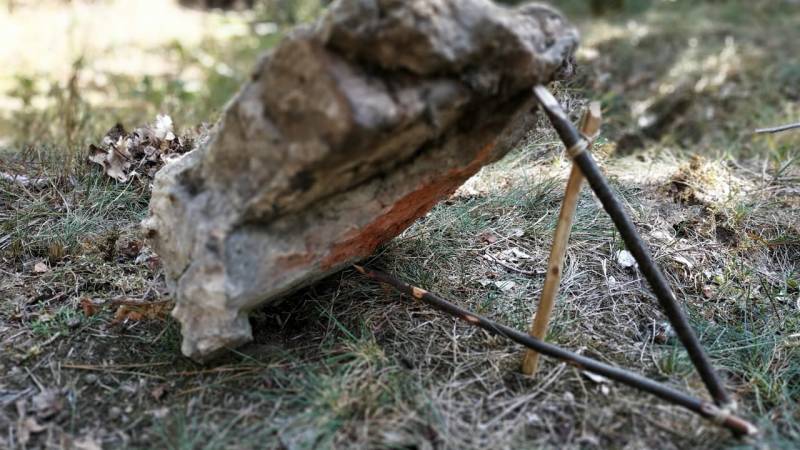
animal traps
Nomen
Meaning
Animal traps are devices used in survival, bushcraft, and wilderness skills to catch animals for food, fur, or self-defense. They are an essential tool for outdoor enthusiasts, hunters, and trappers. Animal traps come in various types, including snares, deadfalls, and cage traps, each designed to capture specific animals. These traps are strategically placed in areas where animals are likely to pass, such as game trails or near water sources. Understanding animal behavior and habitat is crucial for successful trapping. While animal traps are effective for survival purposes, it is important to use them responsibly and ethically, following local regulations and guidelines.

Examples
„I've been out in the wilderness for days now, trying to catch some food. I've set up several animal traps, hoping to catch a rabbit or squirrel.“
„As I checked my animal traps this morning, I was thrilled to find a small rabbit caught in one of them.“
„My friend, who is also into bushcraft, showed me a clever way to construct animal traps using natural materials found in the forest.“
„When I first started learning about survival skills, I was amazed at the variety of animal traps that can be used to catch food in the wild.“
„While discussing our recent camping trip, my friend mentioned how he successfully used animal traps to catch fish in a nearby stream.“
Origin
The word "animal traps" originates from the English language. It is a compound noun formed by combining the words "animal" and "traps".
The word "animal" comes from the Latin word "animalis", which means "living being" or "creature". It has its roots in the Latin word "anima", meaning "soul" or "breath of life".
The word "trap" has Old English and Old Norse origins. In Old English, it was spelled as "træppe" and meant "snare" or "pitfall". In Old Norse, it was spelled as "trǫppa" and had a similar meaning.
Over time, the word "animal traps" has evolved to refer to devices or mechanisms designed to catch or capture animals. These traps can be used for various purposes, such as hunting, pest control, or scientific research.
Synonyms
Animal snares, Wildlife traps, Creature snares, Beast traps, Critter snares, Game traps, Hunting snares, Prey traps
Antonyms
Release, Free, Liberate, Let go, Set free, Emancipate, Unbind, Untie
Relatives
Hunting, Trapping, Snare, Survival skills, Bushcraft, Wildlife, Trapping techniques, Trapping tools
Historical and cultural importance
Animal traps have a long history and cultural significance in the world of survival and hunting. Throughout human history, traps have been used as a means to catch animals for food, fur, or as a form of pest control. Trapping techniques and designs have evolved over time, reflecting the ingenuity and resourcefulness of different cultures.
In ancient times, indigenous peoples around the world developed various types of traps tailored to their specific environments and prey. For example, Native American tribes in North America used pitfall traps, deadfall traps, and snare traps to catch animals such as deer, rabbits, and beavers. These traps were often made from natural materials found in the surrounding wilderness, such as wood, vines, and rocks.
In medieval Europe, trapping became an important skill for survival and trade. Trappers would set up traps in forests and fields to catch animals like foxes, rabbits, and squirrels. The fur from these animals was highly valued and used for clothing and accessories. Trapping also played a role in controlling pest populations that threatened crops and livestock.
Today, animal traps are still used by hunters, trappers, and survivalists around the world. While modern technology has introduced more advanced trapping methods, traditional traps and techniques are still employed by those who appreciate the art and challenge of primitive survival skills. Trapping continues to be an important aspect of wildlife management and conservation efforts, helping to control animal populations and maintain ecological balance.
More information about the term animal traps
Animal Traps: Essential Tools for Survival in the Wild
When it comes to surviving in the wild, one of the most important skills to have is the ability to catch food. In a survival situation, finding and hunting animals can be a challenging task. That's where animal traps come in. These ingenious devices are designed to capture animals for food, fur, or even as a means of self-defense. In this article, we will explore the different types of animal traps and how they can be used effectively in a survival situation.
The Basics of Animal Traps
Animal traps have been used by humans for thousands of years. They are simple yet effective tools that can be made from natural materials found in the wilderness. The basic principle behind animal traps is to lure the animal into a confined space, where it becomes trapped and unable to escape. Traps can be set on land, in water, or even suspended in the air, depending on the target animal and the environment.
Types of Animal Traps
There are several types of animal traps that you should be familiar with in a survival situation:
1. Snare traps: Snare traps are simple loops of wire or cord that are set along animal trails or near their burrows. When an animal walks through the loop, it tightens around their body, trapping them. Snare traps are effective for catching small to medium-sized animals.
2. Deadfall traps: Deadfall traps are designed to crush or immobilize the animal when triggered. They consist of a heavy object, such as a rock or log, that is propped up and held in place by a trigger mechanism. When the animal disturbs the trigger, the object falls, trapping the animal underneath.
3. Pitfall traps: Pitfall traps are holes dug into the ground and covered with leaves or branches. When an animal walks over the covered pit, it falls in and becomes trapped. Pitfall traps are effective for catching small mammals and reptiles.
4. Cage traps: Cage traps are wire or mesh enclosures that are baited to attract animals. When the animal enters the cage to reach the bait, a door or mechanism closes, trapping the animal inside. Cage traps are effective for catching larger animals such as raccoons or rabbits.
Using Animal Traps Safely and Ethically
While animal traps can be effective tools for survival, it is important to use them responsibly and ethically. Here are some guidelines to follow:
- Always check local regulations and laws regarding trapping animals before setting traps.
- Use traps only for survival purposes and never for sport or entertainment.
- Check traps regularly to minimize the suffering of trapped animals.
- Release non-target animals unharmed if caught in the trap.
- Dispose of trapped animals humanely and utilize all parts for food, fur, or other purposes.
Conclusion
Animal traps are essential tools for survival in the wild. They provide a means of catching food and can be made from natural materials found in the wilderness. By understanding the different types of animal traps and using them responsibly, you can increase your chances of survival in a challenging environment. Remember to always prioritize safety and ethical considerations when using animal traps.
Back to overview

